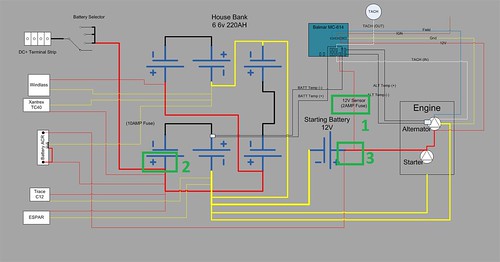Overcharging Problems
Posted on Mon 26 September 2011
(CLICK GRAPHIC TO ENLARGE)
Not sure most of you will want to read this, but to my fellow boaters here goes…
When we had the engine out of the boat to replace the fuel tank we also decided to upgrade our alternator from a 65Amp model to a 100Amp model and to add a Balmar MC614 three-stage external regulator to increase our engine based charging capacity. We also made changes to our battery configuration. We combined all of our existing batteries into one 660Amp Hour (Ah) bank instead of two banks of 440Ah and 220Ah. We also added a single dedicated 12V starting battery.
Our starter is wired to the dedicated starting battery and the alternator charges this battery first. When there is charge being supplied to this battery our Blue Sea 7600 Automatic Charge Relay (ACR) combines the house and starting batteries so the alternator now charges all the batteries. In order for the Balmar external regulator to control the alternator output properly it monitors the voltage of the batteries it is charging (see 1 above). The problem we experienced was our starting battery was being overcharged so much it started to boil the water off. Here is what we think happened.
The two key components in this are where the 12V Sensor wire (1 in the drawing) is attached, 2 the house bank or 3 the starting battery and whether the ACR has the batteries combined or not.
Originally we (myself and our experts) believed the 12V sensor wire could go on either bank since we believed when the ACR saw a charge voltage it would combine the batteries, the regulator would then see the combined voltage of all the batteries and adjust the output of the alternator accordingly. We had the 12V sensor wire attached to the House Bank (2).
We still think that at some lever we’re correct in our assumption, however we now believe there is a race condition where the following happens:
- The Batteries are isolated because the house bank is not at full charge (Undervoltage on the ACR)
- The Engine starts and the regulator is responding to the low voltage on the sensor wire on the house bank (2). It then tells the alternator to output more power
- The ACR can’t “see” the additional power from the alternator because the batteries are not combined so it tells the alternator to output MORE power.
- Now the ACR wakes up (or its sample frequency is less than the regulator) and it sees too much current on the Starting battery and now does not combine the batteries because there is an Overvoltage situation on the starting battery.
The basic problem was the ACR didn’t combine and the regulator was getting mixed signals by monitoring a bank that was not being charged, since the ACR did not combine, while simultaneously charging the hell out of our starting battery. We believe this is what was happening at sea. We know for sure we have reproduced this at the dock.
In order to eliminate this we moved the 12V sensor wire from the house bank to the starting battery. Now regardless of if the ACR combines the battery banks or not at least the regulator is monitoring the voltage of the battery is charging when the ACR has the two banks isolated.
We tested this today and we were not able to get the regulator into an overcharge state. We’re going to test a few more times over the next few days. We’re also going to contact Balmar on Monday and Monty at Englund Marine is going to contact Blue Sea Systems to confirm what we believed happened and that our fix is correct and also just to check to see if they already know something about this happening before.
Another day another thing learned…. ya gotta love it! (DISCLAIMER: We’d love it a lot more if it weren’t foggy and rainy)

